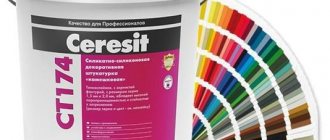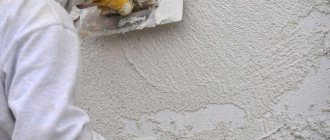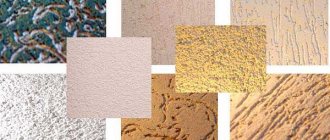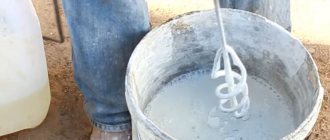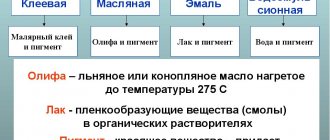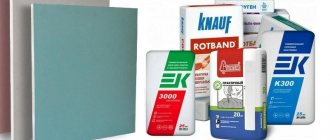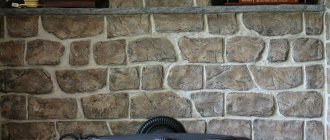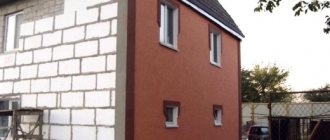Walls are the main part of the interior, and their evenness and the choice of decorative finishing material influence the creation of a holistic, stylish interior. Mineral decorative plaster helps to obtain an even coating and at the same time creates an unusual surface design. This facing material will be discussed in more detail below.
What is mineral plaster
Mineral plaster consists of several components, based on cement, gypsum and other binders. Mineral substances such as sand can serve as filler. By mixing these simple components, you get the simplest version of mineral plaster. The presence of basic mineral elements determines its name.
Mineral plaster consists of several components, based on cement, gypsum and other binders.
Types of mineral plaster, depending on the filler
Fillers are used in the plaster mixture in order to reduce the consumption of binders and to obtain a more stable coating. They help avoid the formation of cracks on the surface and can also give the coating additional properties.
They can be divided into 2 large subspecies:
- Lightweight, their volumetric weight is less than 1000 kilograms per cubic meter;
- Heavy weights, exceeding 1000 kilograms per cubic meter.
The first subtype of fillers includes: sawdust, chopped straw, charcoal, pumice and more. For heavy ones: stone chips, clay, sand, rock flour. According to the size of the fractions, fillers are produced as fine-grained up to half a millimeter and coarse-grained as more than 5 mm.
Fine grain is usually used for finishing inside a building, and coarse grain for exterior work.
Fillers are used in the plaster mixture in order to reduce the consumption of binders and to obtain a more stable coating.
By type, fillers are divided into:
- Decorative. Marble, lapis lazuli, onyx chips, glass balls, quartz sand are used;
- Mosaic, 2-3 types of stone chips are used;
- Colored, with different clays (blue, yellow, red);
- Containing mica;
- Asbestos-cement. They are resistant to high and low temperatures, withstand fire, and are waterproof. It is not often used as insulation;
- Pebble.
Marble, lapis lazuli, onyx chips, glass beads, and quartz sand are used in decorative plasters.
The best way to plaster walls
Which plaster is best for leveling walls depends on a number of factors: the size of the differences in the base surface, resistance to moisture, type of finishing coating, operating conditions.
| Criterion | Cement | Plaster | Decorative |
| Amount of irregularities | Up to 100 mm | Up to 50 mm | From 8 to 17 mm |
| Moisture resistance | Yes | No | Yes |
| Finish coating | Suitable for tiles, wallpaper and painting (subject to puttying) | For wallpaper and painting (no puttying required) | No additional finishing needed |
| Operating conditions (temperature, humidity) | from -50 to +80 degrees, at any humidity | From +5 to +30 degrees Celsius, only for dry, heated rooms | From -50 to +75 degrees, tolerates humid environments well |
| Recommended application | Facade of the building, rooms with high humidity (kitchen, bathroom, industrial buildings) | Bedroom, children's room, corridor | Depending on the type of binder, you can choose a composition for external and internal work |
Important! Plastering walls in an apartment requires the mixture to be environmentally safe, so using the composition for exterior work indoors is prohibited. Applying plaster to the wall can be done with different tools: wide and narrow spatulas, a special machine
For decorative compositions, rollers with embossed nozzles, a trowel, an applicator, and brushes are used.
Applying plaster to the wall can be done with different tools: wide and narrow spatulas, or a special machine. For decorative compositions, rollers with embossed attachments, a trowel, an applicator, and brushes are used.
Composition and characteristics of mineral plasters
The composition and quantity of elements used varies. The main components are:
- Binders. One component can be used, for example cement, or several, then the main element is determined, others will be used in smaller quantities (an example is the use of cement and lime);
- Fillers;
- Plasticizers;
- Modifying substances – flame retardants, biocides, antifreeze;
- Dyes;
- Water.
Characteristics of mineral plaster:
- Specific gravity/volumetric gravity, measured in kilograms per cubic meter;
- The amount of water needed to stir the mixture;
- Strength in kg/cm2;
- Required time for setting;
- Layer thickness, maximum possible and minimum possible;
- Consumption per square meter;
- Indicators of temperature and humidity;
- Adhesion;
- Time required for complete drying.
The composition and quantity of elements used varies.
Nuances of application inside and outside
Each type of mineral plaster has its own application techniques. Therefore, details of how “bark beetle”, “fur coat”, “wet silk”, etc. are applied to the wall can be found in the relevant articles. Here we will consider the nuances characteristic of the bulk of mixtures. Let us immediately note that there are no significant differences between working indoors and outdoors. Application techniques are the same. But there are small tricks unique to this type of plaster.
- All tools are moistened with water before contacting the solution - this prevents the plaster from sticking to the trowel or grater.
- The solution is mixed for one “capture” - the area of the wall onto which the solution can be applied before it sets in the container.
- Restoring the consistency of the solution with water is strictly prohibited. A screwdriver or electric drill with a mixing attachment can help here. If this method fails to restore the fluidity and plasticity of the composition, then the diluted plaster is thrown away.
- The thickness of the plaster layer depends on the size of the filler granules - they must match.
- The final surface treatment is done with a plastic float - the metal leaves marks that cannot be removed.
- During forced breaks, masking tape is applied to the borders of the applied plaster - it slows down the hydration process.
Is it possible to apply mineral plaster to the floor?
Yes, you can, but not the usual plaster for walls. Manufacturers have been producing special flooring mixtures for several years now. There, the types of additives that increase the wear resistance and abrasion of the floor covering have been changed.
Life time
The service life when using mineral plaster for the facade is about 10 years. The harmful effects of the environment contribute to the formation of cracks on the surface of the plaster layer, and over time, the appearance of the facade loses its strength and beauty.
The service life when using mineral plaster for the facade is about 10 years.
Comparison with competing mixtures
To decide on the type of plaster that is best suited for finishing the façade of a house, you need to compare different materials. So, comparing the mineral plaster mixture with silicone, acrylic and silicate, the following conclusions can be drawn:
- The poor elasticity of the mineral type does not allow its use in areas with high seismicity, near railway tracks. In such an area, the wall will quickly become covered with cracks. Acrylic and silicone win in this regard;
- Cheaper than other types;
- Mineral plaster is safer for human health;
- Similar in strength to competitors;
- Acrylic is not suitable for exterior decoration and does not withstand exposure to ultraviolet rays;
- Silicate plaster cannot be used for interior work, it is unsafe for human health, and is used for cladding walls outside;
- Silicone is distinguished by its high cost, but its properties are better.
Mineral plaster is safer for human health.
Popular manufacturers
You can find various plasters from domestic and foreign manufacturers on sale. The following companies make high-quality mineral mixtures:
- "Volma";
- "Baumit";
- "TechnoNIKOL";
- "Ceresit";
- "Eunice";
- "Caparol."
The assortment of any brand includes different materials that differ from each other in the basic composition, the presence of modifiers and polymer additives, color, fraction size and other indicators. The price greatly depends on the manufacturer, as well as on the specific characteristics and quality of the plaster. Typically, rough mixtures are sold at a price of 200-500 rubles/25 kg, decorative ones are more expensive - from 300-600 rubles and more.
Application area
Mineral plaster is used as a rough finishing material when leveling walls, floors, and ceilings. It can serve to insulate walls and protect sheet insulation.
Indoors, gypsum and lime mixtures are more often used, because they are not harmful to health. Due to the property of absorbing moisture and releasing it back in dry microclimates, it is excellent for bedrooms, living rooms, and toilets.
In areas of contact with water, it is necessary to create additional surface protection.
You can also create a decorative coating using this plaster; it is applied with various tools and different fillers are used for texture.
You can create a decorative coating using this plaster.
Types of facade materials: advantages and disadvantages
Plaster protects the walls of the building and gives them an aesthetic and attractive appearance. With its help, you can create various textured patterns and protect structures from moisture. It additionally creates sound insulation, and if necessary, it can be updated and repaired.
Facade materials can be:
- polymer;
- silicate;
- mineral;
- silicone.
Palette of colors and textures.
Mineral plaster is popular because it has a low cost due to the presence of simple components in its composition. It is produced in the form of a dry construction mixture, which is mixed with water before starting work.
This plaster does not have a wide range of colors, but this issue is solved simply: the surface is painted with silicate paint, which penetrates well into the pores of the plaster and strengthens it.
Mineral facade mixture has many positive properties. Its advantages:
- strength;
- non-flammability;
- ease of work;
- good protection against moisture;
- low price.
Flaws:
- a small number of colors (white and gray);
- low resistance to mechanical stress.
Decorative plaster is a modern and extravagant finishing method that has been used for a long time and is now very often used for finishing and restoring facades.
Mineral plaster will give a beautiful look to your building.
Pros and cons of use
Like any material, mineral plaster has its pros and cons. Positive properties include:
- Environmental friendliness;
- Strength;
- Low cost;
- Fire safety;
- Good adhesion;
- Moisture and frost resistance.
Negative sides:
- Cracks from vibrations and surface deformation;
- Not elastic.
Like any material, mineral plaster has its pros and cons.
Wall parameters before applying mineral plaster
To obtain an even and beautiful coating, the surface must meet a number of parameters: the vertical deviation cannot exceed a centimeter on the floor, and three along the entire height of the house; unevenness along the horizontal line cannot be more than one and a half centimeters for every 10 m.
If the finishing material will be applied in a thin layer, then the color of the primer layer should be identical to it.
If the finishing material will be applied in a thin layer, then the color of the primer layer should be identical to it.
Application technology
Plaster compositions are applied to the prepared wall surface in dry weather at temperatures from 5° to 30°; direct sunlight falling on the freshly applied solution is undesirable.
Detected cracks, potholes or other traces of mechanical influences are filled with putty (if the size allows) or, in difficult cases, a continuous leveling layer of sand-cement mixture is applied.
NOTE! The preparatory layer is completely dried for a certain time - experts usually calculate it in the ratio of 1 mm layer - 1 day of drying.
You cannot save time or money on preparation; the durability and quality of the base coating depend on it.
After the preparatory layer has dried, it is primed with deep-penetrating compounds that provide reliable adhesion to the outer layer and strengthen the material throughout its entire thickness.
The application of the main plaster is carried out according to the technology indicated on the packaging of the mixture. The recommended technology should not be changed, since some additives are often introduced into the formulations, requiring special treatment and mandatory actions. Do not also forget that plaster is repairable.
The solution is mixed to the desired consistency (usually the fluidity of thin sour cream is achieved), poured onto the surface for better adhesion and leveled with a grater. When working with “beacons”, a rule is used that allows you to level the surface of the layer in an almost ideal way.
After letting the layer sit for 24 hours, the surface is moistened with water and rubbed to the desired state and painted.
Preparing walls before plastering
First you need to get rid of the old finish, all defects must be eliminated, cracks must be closed. If leveling requires a thick layer, then a mesh should be used. The surface is cleaned of all types of contaminants and degreased. Apply primer and leveling layer.
The surface is cleaned of all types of contaminants and degreased.
Technique for applying mineral plaster
Methods for applying a decorative layer can be varied. The classic option is to apply the plaster vertically using a trowel. They work from one corner part of the room to the other. The layer should be made thin; after applying it, it should be smoothed, reducing the thickness. They work section by section, you need to work quickly so that the solution does not have time to harden. This works over the entire surface.
The layer should be made thin; after applying it, it should be smoothed, reducing the thickness.
Features of plastering work
Applying decorative plaster allows you not only to level the wall, but also to give it a certain relief for beauty and expressiveness.
Facade plaster is applied to fixed meshes for better bonding. Primers are also used, which create a bonding layer, but they cannot be used with a large thickness of the plaster layer.
The mineral facade mixture for laying it in a thicker layer has a coarse filler. This contributes to increased resistance to atmospheric factors. Additives and fillers provide resistance to water penetration into the plaster layer.
Manual labor remained the main method of applying plaster, because attempts to mechanize the process did not produce significant results. In the summer, after finishing work, the plaster should be moistened with water to prevent it from drying out too quickly. It is undesirable to carry out work in cold weather, because the mineral plaster must have time to reliably harden.
The solution is applied to a dry and clean surface.
For work, use only high-quality tools.
Tools used:
- brushes;
- scrapers;
- drill;
- sponges;
- rollers;
- trowel;
- brushes;
- spatulas;
- container for diluting the material.
A stainless steel trowel does not leave rust marks, so it is a good choice of tool for the job.
The simplest option for creating a relief surface is the spray method. After the first layer has dried, another one is applied, and different tools are used to create the texture: a trowel, a sponge and even a broom. To create an interesting pattern on the facade, a solution with a different shade is sprayed onto the surface of one color.
Before the material hardens, it is smoothed with a wet and clean tool.
Watch a video about how plastering work is carried out using a trowel.
Mineral plaster in the interior
Mineral plaster is often used to decorate walls inside offices. It is also suitable for the bathroom; here it is better to choose a pebble type.
“Bark beetle” is popular for renovations in hallways, corridors and stairwells; it looks stylish in these rooms. It is common to use this material to highlight fireplaces, door and window openings. Plaster called “fur coat” helps create a heat-insulating coating for walls.
Mineral plaster is often used to decorate walls inside offices.
Differences between façade and interior plaster
Since the outside of the building is exposed to more severe harmful factors, the plaster should be more durable and resistant to them. Typically, the basis for exterior work in mineral plaster is cement. Some types add components that improve the waterproofing properties of the resulting coating. For interior work, environmental friendliness is important; gypsum and lime are more suitable here.
Since the outside of the building is exposed to more severe harmful factors, the plaster should be more durable and resistant to them.
Is it possible to apply mineral plaster to the floor?
Yes, the use of mineral plaster mixture is permissible for covering the floor, but special types are produced for this purpose. The purpose for the floor is indicated on the packaging of such solutions. They are resistant to abrasion and have better wear resistance.
The use of mineral plaster mixture is acceptable for flooring, but special types are produced for this purpose.
How to make mineral plaster yourself
To prepare your own mineral plaster, you will need to purchase the necessary components, which will differ depending on the required properties of the coating. The components described above are mixed; for this it is better to use a construction mixer. Their ratio is also determined by the type of mixture required. The prepared solution should be applied to the wall immediately, otherwise it may harden quickly.
The prepared solution should be applied to the wall immediately, otherwise it may harden quickly.
Mineral plaster has many positive qualities; it can perfectly complement the interior of a room or decorate the facade of a building. The low cost of the material makes it so popular, and the variety of variations allows you to choose an interesting design.
Cost of materials for facade finishing
Cement-based mineral plaster with polymer additives and pigments is used to apply the material to any building facades.
Depending on the manufacturer, the cost ranges from 400 to 900 rubles per 25 kg bag of mixture.
Facade plaster is made from inexpensive and scarce components, and therefore its cost is in the range of economy-class goods. Any developer can use it for work.
Facade plaster Terol granules has a low price - 560 rubles. Weber min plaster Weber min Bark beetle costs about 800 rubles, and Knauf-Diamant costs only 340 rubles per bag.
Plaster 139 Capatect-Mineral-Leichtputz is a finishing material that consists mainly of natural components. It has 2 textures: “bark beetle” and structural plaster “fur coat”, which have different grain sizes. Price - up to 900 rubles per 25 kg of mixture.
When choosing a plaster mixture, take into account the condition of the building’s facade, the time of work, and your financial capabilities.
Finishing facades with decorative plaster is a fashionable trend, which, due to its high quality and low price, is now very often used for repair and restoration work.
Decorative mineral plaster is a thick composition consisting of natural components, used for finishing work indoors and outdoors. It has become an excellent alternative to wallpaper and, depending on the type, makes it possible to create a variety of wall textures. For cladding facades, material from this series is used: bark beetle or special pebble plaster. Using San Marco plasters, such as Marmo Dautore, you can also finish balconies.
The surfaces created using this material retain their original appearance and layer thickness for a long time. The manufacturer also offers mineral. Its undeniable advantages include high vapor permeability and moisture resistance.
Modern mineral plasters are a unique combination of environmental impeccability and aesthetic perfection.
